Graham Slee Proprius Monoblock Power Amplifiers
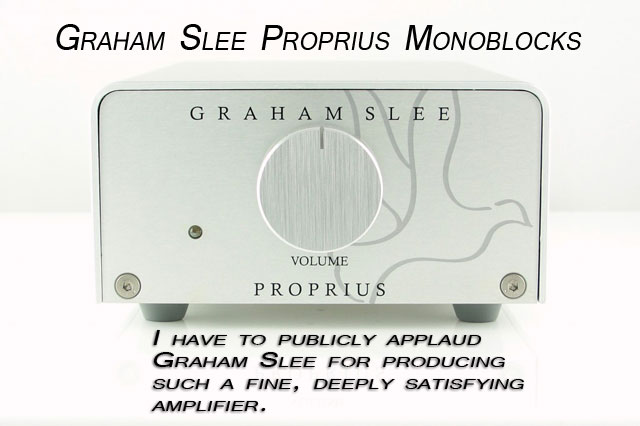
My recent experiences reviewing Graham Slee’s top phono stages – the Accession MM (moving-magnet sensitivity) and the Accession MC (low output moving-coil) – left me so impressed with their musical and sonic transparency that I longed to hear a complete Graham Slee system. If I find one great component in a manufacturer’s line of products, I immediately want to hear all of them.
This habit was formed during my 27 years selling audio components, where in-depth product knowledge was essential to basic competence, but my natural curiosity played an even bigger part. Truly great audio components never happen by accident: if a given designer/company produces one exceptionally great component, it doesn’t take any exceptional leap of faith to suspect that they know what they’re doing.
Graham Slee is a small UK manufacturer whose superb phono stages have set the standard for exceptional performance. Ranging from entry-level pricing to the affordable, but not impulse-buy cheap, the line of Slee phono stages covers the gamut of consumer needs. I’ve reviewed a large number of them over the years and found each one to be of reference quality in their respective price range.
There is an excellent Forum on Graham Slee’s UK website which includes posts by Graham as he develops his products. You can trace the history of many of his products with a primary-source level of directness and insight that I find illuminating.
I’d been aware of the Proprius amps through the corner of my eye for some time, had put them on my list of future review projects, and was deeply curious about how they sound. When Rome Castellanes, head of Slee US distributor LP Gear, offered a review pair in context of my reviews of the two Accessions, I was intrigued.
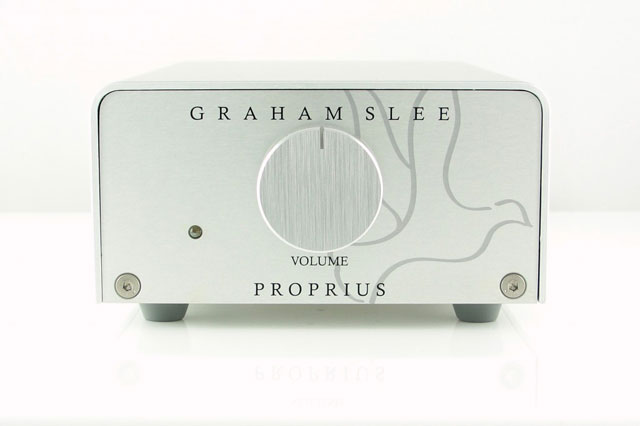
The Proprius amplifier is a mono solid-state amplifier of diminutive size and weight, utilizing an outboard switching power supply. It uses wide-bandwidth, discrete transistor technology, operates in Class A/B, and was designed to produce the ideal sonic virtues that top tube amplifiers (sonic ease, natural instrument timbre, vivid imaging, and freedom from “Transistor-itis”) often exhibit. The goal was to achieve this without the size, weight, cost, heat, and reliability trade-offs that can accompany tube amplification.
The initial impetus for creating the Proprius amps was to serve as an ultra high-quality reference amplifier to aid Graham Slee in developing his other products. The Proprius’ small size was dictated by their potential application of driving monitor-quality loudspeakers (converting them to Activated/Powered status.) An attachment kit is included for those who want to directly connect the amps to the speaker cabinet.
Powered, dedicated, or ’active’ loudspeakers are, of course, a standard format in Pro Audio applications (especially ‘balanced’ XLR designs) and are increasingly popular for desk-top systems. They’ve yet to catch on for high-performance home listening partly because of their “all or nothing” nature: you buy both the manufacturers’ speaker and their amplifiers. Eliminating potential flaws, or simply upgrading by swapping amps to find an ideal match is impossible. The Proprius amps allow you to make your own “dedicated” Active loudspeaker.
The Proprius favors a short speaker cable run, with longer interconnects, and will accept balanced inputs in addition to conventional single-ended connection, though the amp connector is XLR-only. Speaker connection is by bare-wire, spades, or banana plugs. Graham Slee produces interconnects and speaker cable of the proper application to suit individual system needs. Since I own no balanced components, I used a Slee RCA-to-XLR interconnect. This allowed single-ended connection.
 The Proprius amps feature a volume pot on the front panel which allows setting volume for sources without volume controls, and can double as balance controls for sources with volume control. The volume knobs are by-passed when turned fully up. I used the amps connected to an active line stage preamp for most of my auditioning.
The Proprius amps feature a volume pot on the front panel which allows setting volume for sources without volume controls, and can double as balance controls for sources with volume control. The volume knobs are by-passed when turned fully up. I used the amps connected to an active line stage preamp for most of my auditioning.
The Proprius amps do not include AC power cords to their outboard power supplies, and while using garden-variety cords worked well enough; some attention to their quality will pay benefits.
Power output is 25 Watts per channel into 8 Ohms, 45 Watts into a 4-ohm speaker impedance. Like all of Slee products, the unit is designed to be always on. There is no power switch. The Proprius costs $2400 for a stereo pair.
If you detect a strong Pro Audio influence on the Proprius amps your intuition is correct. Slee’s design history includes much work in Pro Audio, including work for the BBC. Although there has been some tension historically between the world of Audiophile Home Audio performance and the Pro Audio world in the USA, where the recording studio section of Pro Audio has been a whipping boy for decades, the two need not be mutually exclusive. This is especially true for the UK where ‘Pro Audio’ is definitely not a synonym for ‘bright, harsh, and grainy.’ The practical, day-to-day demands of Pro Audio products demand a rigor in engineering and design intelligence that is readily transferable to the demands of High Performance home audio products. Ultimately, it all depends on the musical sensitivity and sensibility of the designer.
Reading Slee’s posts on his Forum recounting the development of many of his products offers deep insight into his design methods and choices. What is revealed is a deep mastery of technical matters, intense awareness of costs, size, and sonic trade-offs, all illuminated by his keen musical ear. Slee often speaks of getting it to sound ‘right.’ I find his hearing of ‘right’ very seductive and very sympathetic to my own.
 The Slee Proprius amps are one of the most detailed and natural sounding amps I’ve ever heard. They are not spectacular sounding on first listen, there are no superficial sonic special effects to impress the innocent. Instead, everything on the recording – the ambience of the recording venue, the physical size of it, the placement of the instruments within it, the timbre of the individual instruments, and the depiction of what the instruments are playing is so believable and so natural-sounding that I find myself, without a hint of self-consciousness or irony, applauding after each LP I play. The Proprius is, simply, a superb amp.
The Slee Proprius amps are one of the most detailed and natural sounding amps I’ve ever heard. They are not spectacular sounding on first listen, there are no superficial sonic special effects to impress the innocent. Instead, everything on the recording – the ambience of the recording venue, the physical size of it, the placement of the instruments within it, the timbre of the individual instruments, and the depiction of what the instruments are playing is so believable and so natural-sounding that I find myself, without a hint of self-consciousness or irony, applauding after each LP I play. The Proprius is, simply, a superb amp.
It is completely without any edge, harshness, sterility, or artificial brightness: it produces its exceptional wealth of detail the old-fashioned way – through natural-sounding fidelity. It creates this natural fidelity without dumbing down the signal, smearing transients, rolling-off offending frequency ranges, or any general obfuscation. It tracks and keeps in focus each and every instrument in a recording in a way that allows understanding of what the instruments are doing. Timing, rhythm, phrasing, dynamic punctuation, and expression are simply superb. It does this through eliminating all the distracting unnatural artifacts that one normally has to listen through and try to ignore. As such it has much in common with the best tube amps, pure Class A transistor designs, and other exotic highly natural-sounding amps. Its advantage is its smaller size, ease of use, much cooler running, and lower price.
I used 5 different loudspeakers with the Proprius amps, ranging in sensitivity from the 83 dB Harbeth P3ESR small room near-field monitor, the Sound Lab DynaStat (88 dB at 4 meters electrostatic/dynamic hybrid,) the Spendor 2040 at 87 dB, the Infinity RS7 (87 dB and 4 ohms) to Celestion’s swan-song 90 dB F30 floor-stander. I had no problem filling any of my 3 listening rooms with adequate SPL, but I consciously limit volume levels to a range that won’t cause hearing damage. I’ve done this throughout my life – wearing earplugs at Live Rock concerts (yes, I am a Child of the 60’s) and while riding motorcycles, cupping my hands over my ears in subway tunnels as trains rushed by, and rolling up car windows when passing construction zones. This care (along with the good luck of my genetic inheritance) has resulted in my reaching age 69 with intact hearing to at least 10 kHz. When listening to audio systems I set volume level to just loud enough to hear all the instruments and to capture the recording venue ambience. In my very quiet listening rooms this means sound pressure levels rarely exceed the lower 80’s dB level. These levels, incidentally, are the same that OSSHA sets as safe long-term exposure levels in workplace environments.
The Proprius’ relatively modest power output capability produced no limitations to my listening, and to be honest the best sounding and most musically communicative amplifiers I’ve ever heard have had outputs of 50 watts per channel and less. I routinely run 30 tube watts per channel to my reference Sound Labs Dynastats and have no problems filling a large listening room with full 10-octave response.
Indeed, there is a very compelling school of design that holds the quality of the first watt as the prime determiner of ultimate amplifier accuracy and quality. I offer no quibble to that view, as most of the time in my listening I’m not exceeding one Watt of power, so the quality of that Watt looms much larger than the next 50 or the next 250.
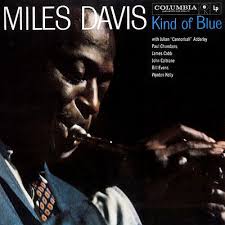 The Proprius amps possess some extraordinary musical virtues which are too often ignored in audio reviews and general audio discussion: the ability to accurately track the relative and changing levels of volume in ensemble playing. On individual instruments, this dynamic tracking allows emotional expression through the subtle variations in volume throughout a given musical line, punctuated by emphasis and de-emphasis. In ensemble playing it allows perception of instrumental interplay, the movement of an instrument from foreground or leading, to supporting, to accompanying, to background, and back again. This aspect of musical communication and expression is common to all music, but is most obvious and most crucial in small combo Jazz and in Classical chamber music and string quartets/quintets. Listen to pianist Bill Evans’ work on Kind of Blue for a sterling example. Schubert’s Quintet in C is also revelatory.
The Proprius amps possess some extraordinary musical virtues which are too often ignored in audio reviews and general audio discussion: the ability to accurately track the relative and changing levels of volume in ensemble playing. On individual instruments, this dynamic tracking allows emotional expression through the subtle variations in volume throughout a given musical line, punctuated by emphasis and de-emphasis. In ensemble playing it allows perception of instrumental interplay, the movement of an instrument from foreground or leading, to supporting, to accompanying, to background, and back again. This aspect of musical communication and expression is common to all music, but is most obvious and most crucial in small combo Jazz and in Classical chamber music and string quartets/quintets. Listen to pianist Bill Evans’ work on Kind of Blue for a sterling example. Schubert’s Quintet in C is also revelatory.
Too often this expressive dynamic tracking is over-simplified by the common dichotomous short-hand of ‘micro/macro’ dynamics. Ignored in that either/or reduction is the fact that macro dynamic sounds simultaneously produce micro dynamic information. Capturing both equally accurately is a prime requisite for true sonic and musical fidelity. It is one area in which analogue playback excels over digital media. Truly I find the homogenization of subtle low-level dynamic changes one of digital’s prime failings and a fatal artistic distortion.
A particularly memorable trait of listening to the Proprius amps was their wonderful depiction of instrument sonority. Not only can one immediately identify the sonic signature of each instrument but one can also revel in its simply beautiful tone. Transistor amps are not usually known for beautiful sonority and I find the Proprii an exceptionally luxurious sensory experience. “Truth is beauty…” This beauty was fully on display playing some of my bete noire instruments – the violin, the piano, the trumpet, and the trombone – all of which sounded accurate, natural, and organic.
Moreover, the Proprii delivers this beauty to even modestly priced loudspeakers, like Celestion’s final incarnation floor-standing F30. The F30’s revealing titanium dome tweeter taxes the sonics of run-of-the-mill transistor amps, but positively bloomed with the Proprii, revealing the highest harmonics of the violin with an ease, detail, and natural-ness that belied the F30’s $400 a pair price point. Alas, Celestion fell victim to the venal stupidity of its last mega-corporation owners and is no more.
 The same fate befell Infinity, once one of the leaders in State-of-the-Art ultra-fi products, in addition to one of the best broad-based product lines in audio history, until their mega-corporation owners whored them out to the Mega Store brothels, and finally killed them off. My pair of 1979 Infinity RS7’s (3-way with EMIT push/pull planar tweeter, polypropylene mid-range and 8-inch acoustic-suspension woofer, 4 Ohm impedance and 87 dB sensitivity) also retailed at $400 a pair and also positively bloomed with the Proprius amps. Spendor’s 2040 floorstanders, designed by Robin Marshall of Epos fame, are a classic ‘British-Sound’ loudspeaker, except for their woofer loading, which incorporate sealed-box acoustic-suspension principles in lieu of the bass reflex which so many classic Brit speakers use. The Spendor’s exceptional musical integrity was brought out by the Proprii, along with its wonderful bass control and clarity.
The same fate befell Infinity, once one of the leaders in State-of-the-Art ultra-fi products, in addition to one of the best broad-based product lines in audio history, until their mega-corporation owners whored them out to the Mega Store brothels, and finally killed them off. My pair of 1979 Infinity RS7’s (3-way with EMIT push/pull planar tweeter, polypropylene mid-range and 8-inch acoustic-suspension woofer, 4 Ohm impedance and 87 dB sensitivity) also retailed at $400 a pair and also positively bloomed with the Proprius amps. Spendor’s 2040 floorstanders, designed by Robin Marshall of Epos fame, are a classic ‘British-Sound’ loudspeaker, except for their woofer loading, which incorporate sealed-box acoustic-suspension principles in lieu of the bass reflex which so many classic Brit speakers use. The Spendor’s exceptional musical integrity was brought out by the Proprii, along with its wonderful bass control and clarity.
Graham Slee used the Harbeth Monitor 20.1 partly in his development of the Proprius amps. I used the Harbeth P3 ESR (the “home” version of that monitor) in both a small-room (9 ft. by 12 ft.) near-field set-up, and in a large room, full 10 octave set-up, incorporating an SVS SB 2000 acoustic-suspension, powered subwoofer.
The small-room, near-field listening set-up is still one of the most successful strategies to attain ultra-fidelity in home listening. The small room size means power requirements to fill the room nose-dive, the speakers can be easily positioned for maximum stereophonic hallucinations, and the mini-monitors’ limited bass extension can be reinforced enough by the small room’s dimensions to give satisfying bass.
Sonic and musical results with this Harbeth/Proprius small room set-up were truly exceptional. The Harbeth’s acoustic suspension woofer extends to 75 Hz before beginning its shallow roll-off. In-room response, reinforced by the small room dimensions, extended the bass into the high 40 Hz range. There was an electrostatic clarity, natural-ness, and ultra-resolution to this pairing – a musical integrity – that was immensely compelling and deeply aesthetically satisfying. No it couldn’t do cathedral organ music well, but..
For cathedral organ (and other low-bass work-outs) I used the Harbeth/Proprius in my large reference room which permits full 10 octave playback (my reference Sound Lab Dynastats are flat to 22 Hz in this room.) With the crossover of the subwoofer set to 80 Hz, the work load on the Harbeth’s woofer was vastly reduced and the Proprii had more than enough power to drive the 83 dB sensitive P3 ESR to my normal listening levels. The results, except for ultimate transparency and instrument size, caused my reference Sound Labs to lean over and query somewhat tremulously, “Who are these guys?”
My attempts to drive the Dynastats full-range with the Proprius amps were less successful. The speaker features a 6 foot tall di-pole electrostatic panel mated to a 10 inch bass-reflex woofer crossing over at 250 Hz (Middle C on the piano.) Sensitivity is 88 dB at 4 meters and the impedance is a flat 8 Ohms. It should be a relatively easy, though complex, load to drive in theory, but practically it’s been a question of try it and see regarding amp choice. Tube amplifiers with exceptionally good output transformers (rarer and rarer these days) have been the most successful in dealing with the need to drive both a conventional dynamic resistive load (the woofer) and the capacitive reactive load of the electrostatic panels.
 When facing this speaker load, otherwise exceptional transistor amps have typically lost all top-end response and clarity, or turned bright, hard, and metallic. The Proprii produced only a slight diminution in ultra top–end clarity through the panels compared to my reference tube amp, though the bass volume and drive dropped to the point where the speaker sounded unbalanced. Though the Dynastats allow bi-amping through their internal crossover, I was unable to try this as I did not have 4 Proprii amps. My intuition, based on past experience with this speaker, is that multiple amplifiers would have solved this weakness. I don’t downgrade transistor amps that can’t drive the Dynastats full-range well; it’s too esoteric a speaker-load to disqualify the bulk of excellent transistor amps for one serious limitation.
When facing this speaker load, otherwise exceptional transistor amps have typically lost all top-end response and clarity, or turned bright, hard, and metallic. The Proprii produced only a slight diminution in ultra top–end clarity through the panels compared to my reference tube amp, though the bass volume and drive dropped to the point where the speaker sounded unbalanced. Though the Dynastats allow bi-amping through their internal crossover, I was unable to try this as I did not have 4 Proprii amps. My intuition, based on past experience with this speaker, is that multiple amplifiers would have solved this weakness. I don’t downgrade transistor amps that can’t drive the Dynastats full-range well; it’s too esoteric a speaker-load to disqualify the bulk of excellent transistor amps for one serious limitation.
If one was to characterize the sound of the Proprius amps, one wouldn’t be far off in describing them as similar to the very best British loudspeakers that spun out of the pioneering efforts of the classic BBC research efforts into monitor speakers. They share an exceptionally natural sounding, detailed clarity and transparent musicality, with full rather than austere bass performance.
A common view among devotees of Analogue LP/Tube playback is that that the CD finished what the Transistor started. Coldness, harshness, sterility, and listening fatigue are still the most common complaint of listeners dissatisfied with the sound of their systems. This critique dates back to the earliest transistor amps of the mid-1960’s. I recently had a chance to listen to an early transistor integrated amp from the mid-1960’s, one old enough to still use germanium transistors. The brightness and glare – “Transistor-itis” – was painfully abominable, very reminiscent of my experience of the original launch of the CD.
While the horrors of the transistor amp have long been vanquished, many keen listeners still hold the tube amp as top-of-the hill for producing totally convincing musical illusions. I have to count myself as one, particularly for Classical music. I have, however, experienced enough truly superb solid-state amps to know that solid state amps can possess their own excellence and can deliver aesthetic experiences as profound and deeply satisfying as tube amps. The Graham Slee Proprius is one such amplifier. Just as I privately applauded after each LP when listening to the Proprius amps, I have to publicly applaud Graham Slee for producing such a fine, deeply satisfying amplifier.

![]()
paul szabady
Specifications:
Price: $2,400 per pair
Power output (rms) measured26 Watts into 8 Ohms; 45.5 Watts into 4 Ohms (ref 1% THD+N at 1kHz)
Power bandwidth at rated power into 8 Ohms10Hz – 47kHz (-3dB), 20Hz – 25kHz (-1dB)
Power bandwidth at rated power into 4 Ohms: 12Hz – 40kHz (-3dB)
Total harmonic distortion and noise at 8 Ohms: 100Hz: 0.043%; 1kHz: 0.047%; 5kHz: 0.061%; 10kHz: 0.085%; 20kHz: 0.125%
Total harmonic distortion and noise at 4 Ohms: 100Hz: 0.066%; 1kHz: 0.071%; 5kHz: 0.094%; 10kHz: 0.129%; 20kHz: 0.181%
Signal to noise ratio in dB: “A-weighted”: 87dB; 22Hz-22kHz “Q-pk”: 80dB
Bias type: Class A/B; Bias current: 60mA (approx.)
Input sensitivity for rated output: 575mV rms
Short circuit protection: Fuse and power supply shut-down (short circuits should be avoided to prevent component stresses)
FuseF2A 5mm x 20mm (glass “quick-blow” fuse rated at 2A)
Power supply:48V DC, 120 Watt – self adjusting to AC mains 100V – 240V, 47 – 63 Hz; IEC cord supplied
Size (approx.): Amp W105 x H55 x D205 mm; Power supply W65 H40 D170 mm
Graham Slee
HiFi System Components Limited
6 Buttercross Drive
Little Houghton, S72 0HS
England
+44 (0) 1909 568739
+44 (0) 7947 107188
+44 (0) 1226 755328
e-mail: gsp.ltd@gspaudio.co.uk
website: www.hifisystemcomponents.com
twitter: twitter.com/gspaudio
US Distributor:
LP Gear
3024 Via VeneziaHenderson, NV 89052 US
Fax: (725) 888-4711
Stereo Times Masthead
Publisher/Founder
Clement Perry
Editor
Dave Thomas
Senior Editors
Frank Alles, Mike Girardi, Russell Lichter, Terry London, Moreno Mitchell, Paul Szabady, Bill Wells, Mike Wright, and Stephen Yan,
Current Contributors
David Abramson, Tim Barrall, Dave Allison, Ron Cook, Lewis Dardick, John Hoffman, Dan Secula, Don Shaulis, Greg Simmons, Eric Teh, Greg Voth, Richard Willie, Ed Van Winkle, Rob Dockery, Richard Doron, and Daveed Turek
Site Management Clement Perry
Ad Designer: Martin Perry


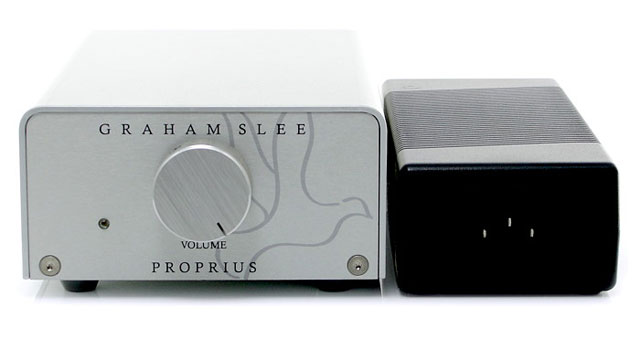
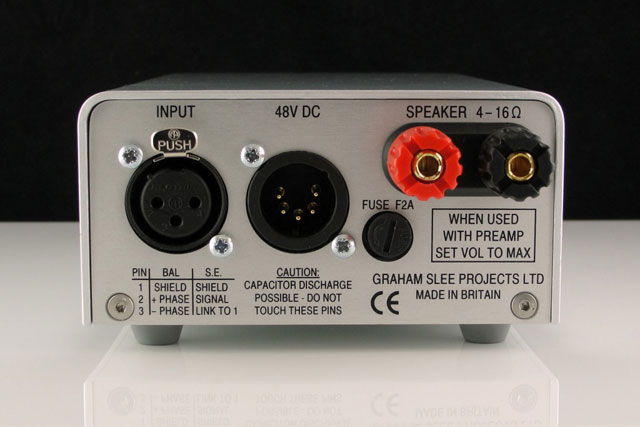




Be the first to comment on: Graham Slee Proprius Monoblock Power Amplifiers